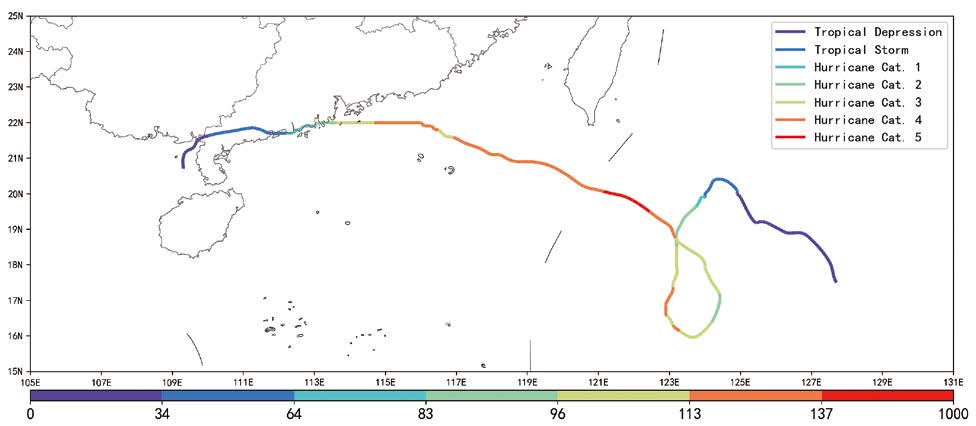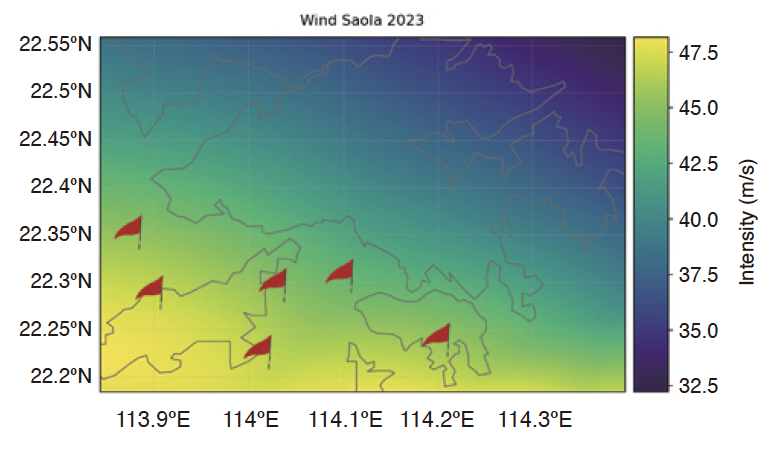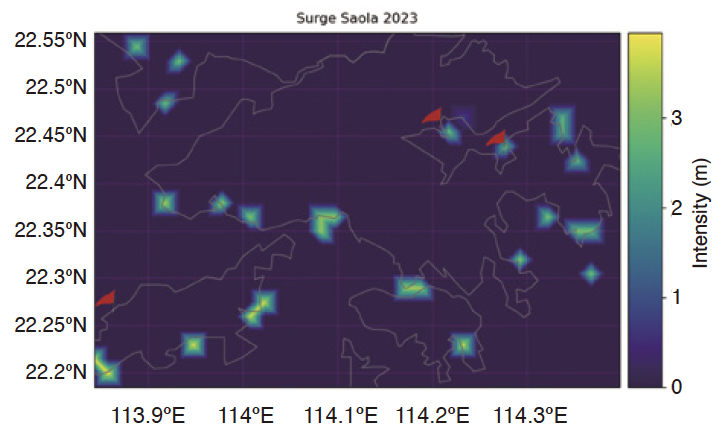
HKU Jockey Club Enterprise Sustainability Global Research Institute
World-Class Hub for Sustainability
HomeHong Kong Economic Policy Gree...1.2 Devastating Consequences o...
1. Overview of Climate Risks in Hong Kong
1.2 Devastating Consequences of Super Typhoons: Recent Experiences
A recent example is Super Typhoon “Saola,” the third tropical cyclone to impact Hong Kong in 2023, prompting the HKO to issue a No. 10 Signal. At its center, “Saola” reached a maximum sustained wind speed of 210 kilometers per hour, setting a new record in Hong Kong’s typhoon history. Figure 3 plots the path of “Saola”, which formed in the Pacific Ocean, made its first landfall in Hong Kong, and subsequently impacted Guangdong Province in China.
Figure 3. Observed path of “Saola” in 2023.

Notes: The trajectory and intensity map of “Saola.” The color intensity from purple to red represents the escalating severity of the typhoon’s influence. “Saola” demonstrated considerable force, with wind speeds ranging from 96 to 113 knots. (Data source: YoujiVest Climate Lab)
Figure 4A shows the wind intensity during “Saola.” We observe that the southwestern parts of Hong Kong, including areas such as Ngong Ping, Sha Chau, Cheung Chau, Ping Chau, Tsing Chau (as flagged in Figure 4A), and the southern part of Hong Kong Island, experienced more pronounced wind impacts.
The strong winds led to severe destruction, including shattered glass, fallen trees, and damaged infrastructures. In addition to the strong winds, “Saola” also triggered a storm surge, causing a rapid rise in tidal levels. Figure 4B shows that the rise in the tidal level was mainly concentrated in the bays, especially in the bay areas of Sha Tin, Tai Po, and Tai O. The water brought by the storm surge not only destroyed many boats in the bays but also caused widespread floods that eroded coastal lands, roads, and properties. Many parts of Hong Kong experienced waterlogging on streets, traffic congestion, and significant delays in public transportation.
According to the Hong Kong Insurance Authority, the total gross claims caused by “Saola” and a subsequent black rainstorm reached HK $1.9 billion. The most insurance claims were for property damage and business interruption, with a total compensation of HK $1.64 billion. Employee compensation, automotive, and travel claims amounted to HK $210 million.
Figure 4. Typhoon “Saola’s” impact on wind and storm surge.
Panel A. Observed Wind Intensity of “Saola”

Panel B. Observed Surge Height of “Saola”.

Notes: The figure shows the distribution of impacts from “Saola” across regions in Hong Kong in two panels. Panel A (Left) shows the distribution of wind intensity impacts. The intensity gradients range from blue to yellow, indicating increasing strength. The highest wind intensities were recorded from the southwest to the northeast of Hong Kong within a range of 32.5 m/s to 47.5 m/s. Panel B (Right) displays the distribution of storm surge intensity impacts. The intensity of the storm surge, measured by the height of the surge, is indicated by a color gradient from blue to yellow. (Data source: YoujiVest Climate Lab)